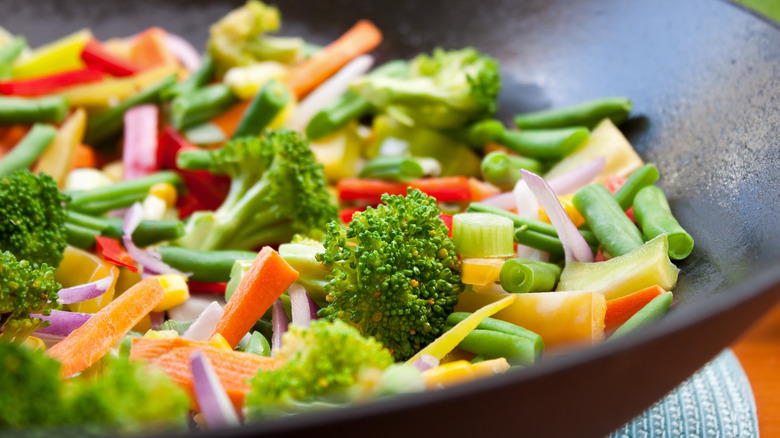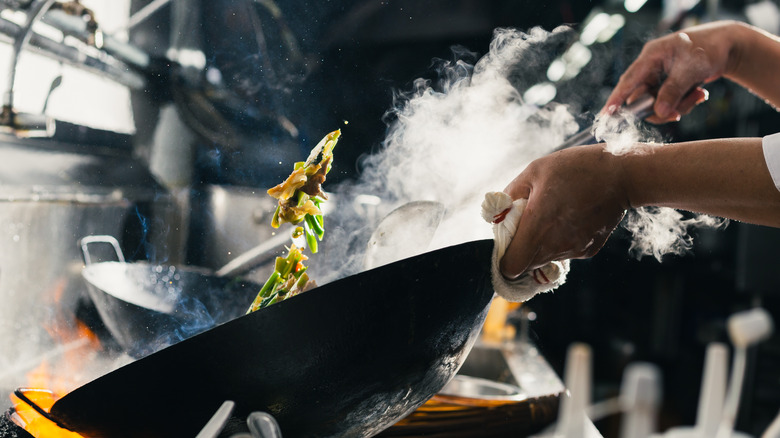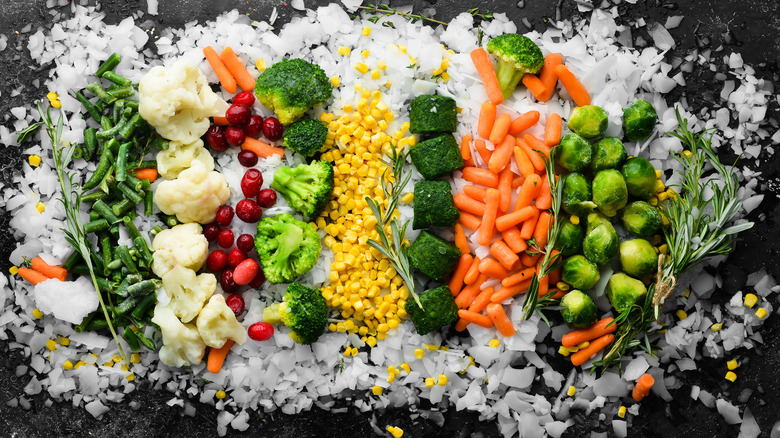How To Stir-Fry Frozen Veggies For A Deliciously Crisp Finish
Vegetable stir-fries are a great way to work more vegetables into your diet without having to skip out on flavor. Using just a little bit of oil, a light sauce or marinade, and a hot pan can result in an intensely smoky, crispy meal. If you can manage to do it using frozen vegetables too, then you're just stacking up the benefits.
Frozen vegetables might have a bad rap to some, but they actually have a lot of advantages. If you're stocking up on some with hopes of making the best stir-fry possible, then avoid common mistakes when buying frozen vegetables – like purchasing ones that have clumped together in the bag or box.
If you want your vegetables to stay crisp and delicious instead of turning into a soggy mess then you need to add them directly to the hot pan instead of defrosting them. Conventional wisdom might tell you otherwise because of the ways that we treat meat and other ingredients, but in the case of frozen vegetables, you actually want to start cooking them while they're still frozen.
A hot pan is key for crispy stir-fry
Whether you're using a classic wok or a Western-style frying pan for your stir-fry, you'll want to start with a hot pan. This is the key to quickly defrosting your frozen vegetables and cooking them evenly. You want your pan to be hot enough that the oil has started to smoke lightly, then add your frozen vegetables. You'll want to keep moving your vegetables around quickly to ensure that each side is exposed to the heat as they cook.
You should also work in smaller batches. This will ensure that all of the extra moisture doesn't steam the vegetables too much. You need a dry heat to get a crispy exterior. If you have too many vegetables in the pan at one time, then all the moisture will turn to steam and may soften them without ever browning properly. From here you can add aromatics like garlic and ginger, or season the vegetables with soy sauce or other umami flavorings.
Benefits of using frozen vegetables
Once you get this technique down you'll want to keep a bag of frozen vegetables on hand to make this as often as you can. Broccoli, cauliflower, sugar snap peas, carrots, and corn are all great options to mix together to create a wide variety of flavors and textures in your stir-fry. Because they're frozen, they have a much longer shelf life than fresh produce that goes to waste if you don't remember to cook it soon enough.
Frozen vegetables are typically superior to canned as well. Unlike canned vegetables, most frozen vegetables go through minimal processing once they're picked. The most extreme measures usually taken are a quick blanching, which also helps them cook more quickly. Blanching traps in water, cooks the vegetables slightly, and helps preserve their texture throughout the freezing and packaging processes. Canned vegetables don't always hold up as well in comparison because they're boiled as a means of sterilization.
Frozen vegetables have also been found to be comparable to fresh in terms of nutrition. There are multiple factors that can influence this such as the type of vegetable itself, or the ripeness of a fresh vegetable, but there isn't one category that reigns supreme as the most nutritious. In some cases, the freezing process has shown to increase the presence of some nutrients like antioxidants in kale or riboflavin in broccoli. So take this tip for crispy stir-fry vegetables and make some quick and nutritious weeknight meals.


